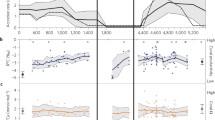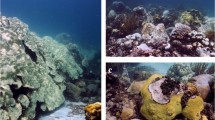Abstract.
Widespread thermal anomalies in 1997–1998, due primarily to regional effects of the El Niño–Southern Oscillation and possibly augmented by global warming, caused severe coral bleaching worldwide. Corals in all habitats along the Belizean barrier reef bleached as a result of elevated sea temperatures in the summer and fall of 1998, and in fore-reef habitats of the outer barrier reef and offshore platforms they showed signs of recovery in 1999. In contrast, coral populations on reefs in the central shelf lagoon died off catastrophically. Based on an analysis of reef cores, this was the first bleaching-induced mass coral mortality in the central lagoon in at least the last 3,000 years. Satellite data for the Channel Cay reef complex, the most intensively studied of the lagoonal reefs, revealed a prolonged period of elevated sea-surface temperatures (SSTs) in the late summer and early fall of 1998. From 18 September to 1 October 1998, anomalies around this reef averaged +2.2°C, peaking at 4.0°C above the local HotSpot threshold. In situ temperature records from a nearby site corroborated the observation that the late summer and early fall of 1998 were extraordinarily warm compared to other years. The lettuce coral, Agaricia tenuifolia, which was the dominant occupant of space on reef slopes in the central lagoon, was nearly eradicated at Channel Cay between October 1998 and January 1999. Although the loss of Ag. tenuifolia opened extensive areas of carbonate substrate for colonization, coral cover remained extremely low and coral recruitment was depressed through March 2001. High densities of the sea urchin Echinometra viridis kept the cover of fleshy and filamentous macroalgae to low levels, but the cover of an encrusting sponge, Chondrilla cf. nucula, increased. Further increases in sponge cover will impede the recovery of Ag. tenuifolia and other coral species by decreasing the availability of substrate for recruitment and growth. If coral populations are depressed on a long-term basis, the vertical accretion of skeletal carbonates at Channel Cay will slow or cease over the coming decades, a time during which global-warming scenarios predict accelerated sea-level rise.
Similar content being viewed by others
Author information
Authors and Affiliations
Additional information
Electronic Publication
Rights and permissions
About this article
Cite this article
Aronson, .R., Precht, .W., Toscano, .M. et al. The 1998 bleaching event and its aftermath on a coral reef in Belize. Marine Biology 141, 435–447 (2002). https://doi.org/10.1007/s00227-002-0842-5
Received:
Accepted:
Issue Date:
DOI: https://doi.org/10.1007/s00227-002-0842-5




